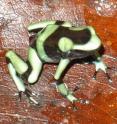Frog-killing fungus paralyzes amphibian immune response
A fungus that is killing frogs and other amphibians around the world releases a toxic factor that disables the amphibian immune response, Vanderbilt University investigators report Oct. 18 in the journal Science. The findings represent "a step forward in understanding a long-standing puzzle -- why the amphibian immune system seems to be so inept at clearing the fungus," said Louise Rollins-Smith, Ph.D., associate professor of Pathology, Microbiology and Immunology. Although the identity of the toxic fungal factor (or factors) remains a mystery, its ability to inhibit a wide range of cell types -- including cancerous cells -- suggests that it may offer new directions for the development of immunosuppressive or anti-cancer agents.
The populations of amphibian species have been declining worldwide for more than 40 years. In the late 1990s, researchers discovered that an ancient fungus, Batrachochytrium dendrobatidis, was causing skin infections, and the fungus is now recognized as a leading contributor to global amphibian decline.
Rollins-Smith, an immunologist, and her colleagues have been studying the immune response to the fungus for more than 10 years.
"Amphibians have excellent and complex immune systems -- nearly as complex as humans -- and they should be able to recognize and clear the fungus," she said.
In early studies, the investigators demonstrated that some frogs produce anti-microbial peptides in the skin that offer a first layer of defense against the fungus. But when the fungus gets into the layers of the skin, Rollins-Smith said, the conventional lymphocyte (immune cell)-mediated immune response should be activated to clear it.
They found in the current studies that recognition of the fungus by macrophage and neutrophil cells was not impaired.
"We think it's not a block at the initial recognition stage," Rollins-Smith said. "The macrophages and neutrophils can see it as a pathogen, they can eat it up, they can do their thing."
But during the next stage of the immune response, when lymphocytes should be activated, the fungus exerts its toxic effects. The investigators demonstrated that B. dendrobatidis cells and supernatants (the incubation liquid separated from the cells) impaired lymphocyte proliferation and induced cell death of lymphocytes from frogs, mice and humans. The toxic fungal factor also inhibited the growth of cancerous mammalian cell lines.
The toxic factor was resistant to heat and proteases (enzymes that cut proteins into pieces), suggesting that it is not a protein. It appears to be a component of the cell wall, because drugs that interfere with cell wall synthesis reduce its inhibitory activity and because the zoospore -- an immature form of the fungus that lacks a cell wall -- does not produce the factor.
The new findings suggest the possibility that toxic factors -- in addition to acting locally to inhibit the immune response -- might also get into the circulation and have neurotoxic effects, Rollins-Smith said.
"Fungal infection causes rapid behavioral changes -- frogs become lethargic and start to crawl out of the water -- suggesting that even though the fungus stays in the skin, the toxic material is having effects elsewhere."
The studies, led by graduate students J. Scott Fites and Jeremy Ramsey, could also suggest new conservation measures for species that may be medically important.
"Amphibian skin has long been favored in folklore for its medicinal properties," Rollins-Smith said. "Frogs are a rich source of potentially useful molecules that might work against human pathogens."
The research was supported by grants from the National Science Foundation. Other authors of the Science paper include Whitney Holden, Sarah Collier, Danica Sutherland, Laura Reinert, Sophia Gayek, Terence Dermody, M.D., Thomas Aune, Ph.D., and Kyra Oswald-Richter, Ph.D.
Source: Vanderbilt University Medical Center
Other sources
- Frog-killing fungus paralyzes amphibian immune responsefrom Biology News NetThu, 17 Oct 2013, 23:00:28 UTC
- Devastating frog fungus triggers suicide by immune cellsfrom MSNBC: ScienceThu, 17 Oct 2013, 21:00:50 UTC
- Frog-killing fungus paralyzes amphibian immune responsefrom Science DailyThu, 17 Oct 2013, 19:30:45 UTC
- Devastating Frog Fungus Triggers Cell Suicidesfrom Live ScienceThu, 17 Oct 2013, 18:30:45 UTC
- Frog-killing fungus paralyzes amphibian immune responsefrom PhysorgThu, 17 Oct 2013, 18:00:39 UTC
